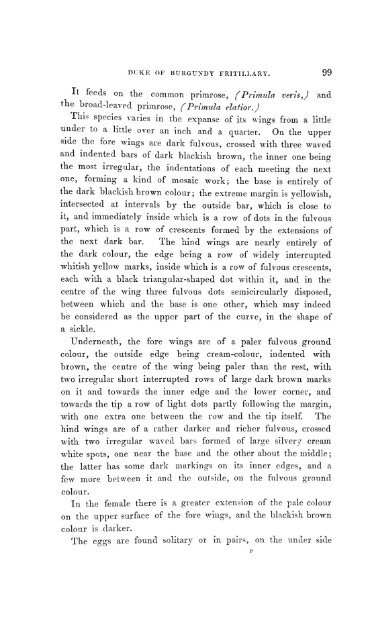S-1141001_COMPLETO.pdf
S-1141001_COMPLETO.pdf
S-1141001_COMPLETO.pdf
You also want an ePaper? Increase the reach of your titles
YUMPU automatically turns print PDFs into web optimized ePapers that Google loves.
DUKE OF BURGUNDY FRITILLARY. 99<br />
It feeds on the common primrose, (Primula verts,J and<br />
the broad-leaved primrose, (Primula elatior.J<br />
This species varies in the expanse of its wings from a little<br />
under to a little over an inch and a quarter. On the upper<br />
side the fore wings are dark fulvous, crossed with three waved<br />
and indented bars of dark blackish brown, the inner one being<br />
the most irregular, the indentations of each meeting the next<br />
one, forming a kind of mosaic work; the base is entirely of<br />
the dark blackish brown colour; the extreme margin is yelloAvish,<br />
intersected at intervals by the outside bar, which is close to<br />
it, and immediately inside which is a TOAV of dots in the fulvous<br />
part, which is a row of crescents formed by the extensions of<br />
the next dark bar. The hind wings are nearly entirely of<br />
the dark colour, the edge being a row of widely interrupted<br />
whitish yelloAv marks, inside which is a row of fulvous crescents,<br />
each with a black triangular-shaped dot within it, and in the<br />
centre of the wing three fulvous dots semicircularly disposed,<br />
between which and the base is one other, Avhich may indeed<br />
be considered as the upper part of the curve, in the shape of<br />
a sickle.<br />
Underneath, the fore wings are of a paler fulvous ground<br />
colour, the outside edge being cream-colour, indented with<br />
brown, the centre of the wing being paler than the rest, with<br />
two irregular short interrupted rows of large dark brown marks<br />
on it and toAvards the inner edge and the lower corner, and<br />
towards the tip a row of light dots partly folloAving the margin,<br />
with one extra one between the TOAV and the tip itself. The<br />
hind wings are of a rather darker and richer fulvous, crossed<br />
with two irregular Avaved bars formed of large silvery cream<br />
white spots, one near the base and the other about the middle;<br />
the latter has some dark markings on its inner edges, and a<br />
few more between it and the outside, on the fulvous ground<br />
colour.<br />
In the female there is a greater extension of the pale colour<br />
on the upper surface of the fore wings, and the blackish broAvn<br />
colour is darker.<br />
The eo-gs are found solitary or in pairs, on the under side

















